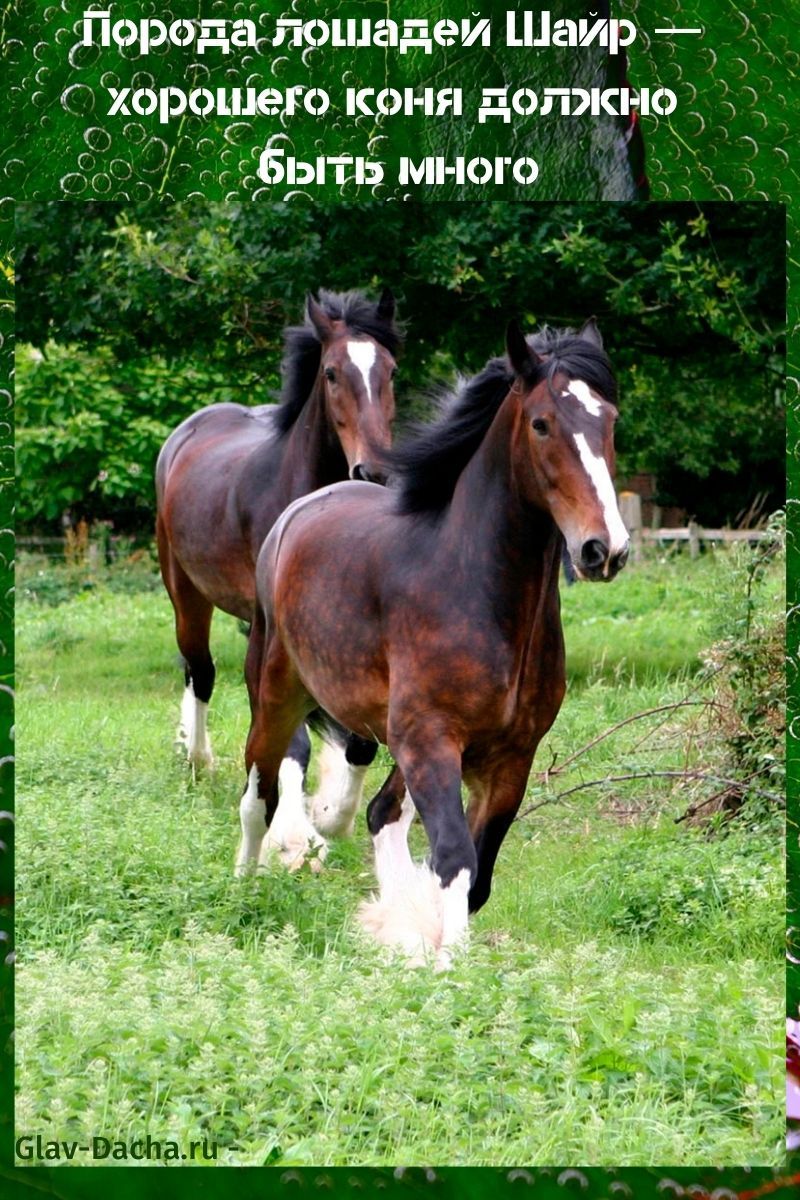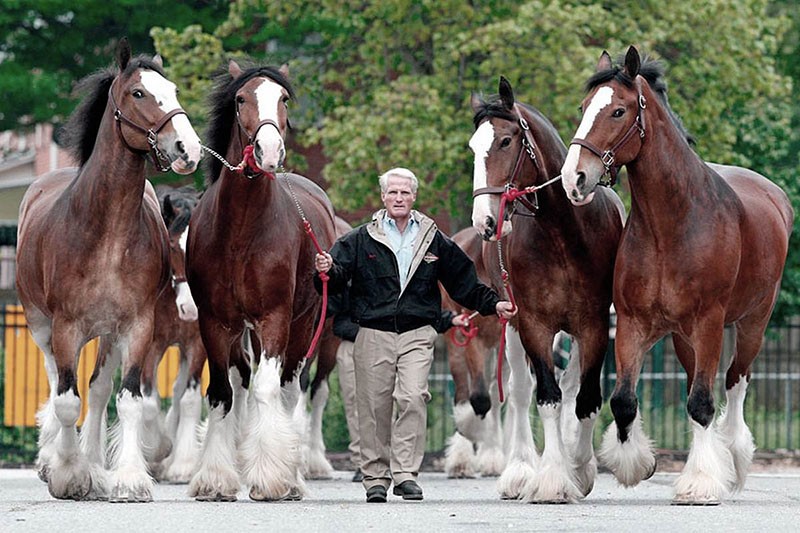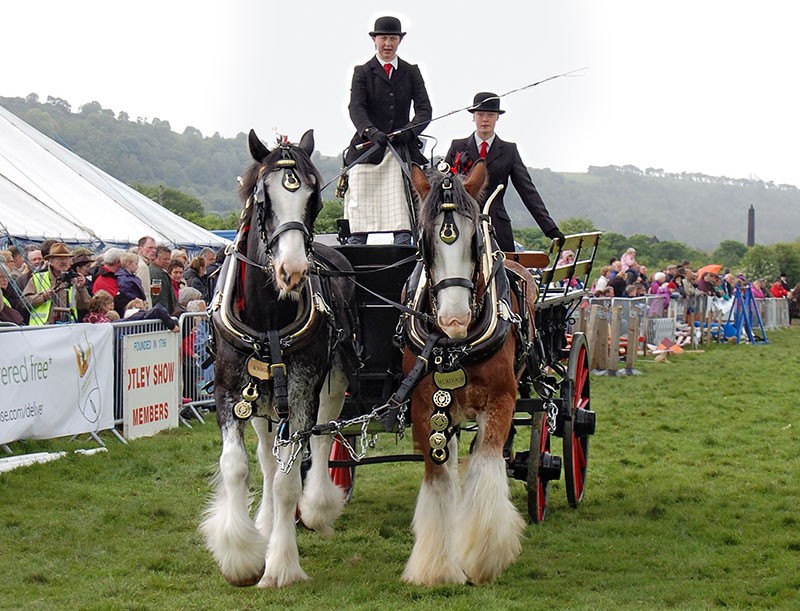Shire horse breed - there should be a lot of good horse
 The largest representative of the genus is the Shire horse breed. Despite the formidable appearance, large size and impressive weight, the animals are distinguished by a rather good-natured disposition. These real "titans" were widely used during military parades, as well as in agriculture. The breed is one of the best in its class, therefore it is especially popular in breeding. Impressive growth and spectacular movements add special pomp to them. At exhibitions, shows and competitions, these giants are out of competition.
The largest representative of the genus is the Shire horse breed. Despite the formidable appearance, large size and impressive weight, the animals are distinguished by a rather good-natured disposition. These real "titans" were widely used during military parades, as well as in agriculture. The breed is one of the best in its class, therefore it is especially popular in breeding. Impressive growth and spectacular movements add special pomp to them. At exhibitions, shows and competitions, these giants are out of competition.
From the pages of history


As a result, the distinctive characteristics of the breed of steel:
- massiveness;
- well-developed muscles;
- physical strength.
There are historical records dating back to 1878 that the ancestor of the Shire was a stallion, nicknamed the "Blind Horse" from the small settlement of Packington.
Nevertheless, the Frisian genes slightly refined the crosses, giving them a certain ease and freedom of movement. Thanks to such improvements, heavy trucks began to be successfully used for military and agricultural purposes, as well as for movement in sledges (carriages, carriages). In connection with mechanization, which rapidly entered society, the need for them has significantly decreased, which led to the degeneration of the breed.
 In the 60s of the last century, some breeders were intensively engaged in the restoration of the livestock of the English heavy truck Shire. Breeders actively crossed cross-breeds and Clydesdals. This is how horses with a stronger physique turned out. Nevertheless, this entailed a change in the character of the horses and the hairy pubescence of the lower leg. Today in the American population there are about 2 thousand individuals, and in the British - 1.5 thousand.
In the 60s of the last century, some breeders were intensively engaged in the restoration of the livestock of the English heavy truck Shire. Breeders actively crossed cross-breeds and Clydesdals. This is how horses with a stronger physique turned out. Nevertheless, this entailed a change in the character of the horses and the hairy pubescence of the lower leg. Today in the American population there are about 2 thousand individuals, and in the British - 1.5 thousand.
With sufficient overall dimensions, shires require much more feed, which means abundant pastures.
In addition, when mating stallions, a mare corresponding to their constitution is selected for them. Otherwise, you get very ugly descendants with a bad character.
Shire horse breed - small details of great importance
 Due to a rather complex past, modern crosses are not like their medieval predecessors. The main feature of the current members of the class is the proportional development of each part of the body. The wide back is in good harmony with the massive chest and sacrum. Thanks to this, they are distinguished by unique endurance and remarkable strength. In addition, the animals hold the body perfectly. A characteristic feature of shires is their high growth, which at the withers reaches from 165 to 185 cm, as well as a weight that ranges from 850-1500 kg.
Due to a rather complex past, modern crosses are not like their medieval predecessors. The main feature of the current members of the class is the proportional development of each part of the body. The wide back is in good harmony with the massive chest and sacrum. Thanks to this, they are distinguished by unique endurance and remarkable strength. In addition, the animals hold the body perfectly. A characteristic feature of shires is their high growth, which at the withers reaches from 165 to 185 cm, as well as a weight that ranges from 850-1500 kg.
The most popular coloring pages of the horse breed Shire:
- black;
- bay;
- gray.
 A typical sign of individuals is the presence of a bald spot on the head, as well as white stockings on the hind legs (in most cases). In addition, star-shaped spots are common in these areas. Crossing with Clydesdals resulted in thick, long and silky friezes on the limbs of the animals. On the hind legs, they are more pronounced and asymmetrical, since they grow from the hock joint. The metacarpus has a pronounced rounded shape, which indicates the powerful development of ligaments and tendons.
A typical sign of individuals is the presence of a bald spot on the head, as well as white stockings on the hind legs (in most cases). In addition, star-shaped spots are common in these areas. Crossing with Clydesdals resulted in thick, long and silky friezes on the limbs of the animals. On the hind legs, they are more pronounced and asymmetrical, since they grow from the hock joint. The metacarpus has a pronounced rounded shape, which indicates the powerful development of ligaments and tendons.
The natural beauty of the breed is emphasized by such features of appearance.:
- large and elongated head;
- big eyes;
- wide forehead;
- small ears;
- short, slightly curved neck;
- hump on the nose.
The record holder among the Shire is a stallion named Mammoth (born in 1848). The height of the individual was 219 cm, and the weight was more than 1500 kg.
The tail set is high enough to create amazing designer hairstyles. A lush, long and beautiful mane complements this idyll of beauty. Together with such an attractive appearance, the Shire horse breed impresses with its calm and flexible character. Animals are excellent for training, because they quickly find contact with their owners. Thanks to their balanced temperament, they learn new skills in just a couple of weeks. Often they are used when teaching children to ride. In addition, the animals are very easy to handle, which is a significant advantage of the breed.
Features of the content
 The average life span of a Shire is 20-35 years. This figure largely depends on the conditions of keeping British heavy trucks. Like all members of their family, they need cleanliness and care. Excessive freezing is a significant disadvantage of the breed of large gray horses. Long brushes often get wet and dirty, which leads to the appearance of woodlice, as well as the development of pathogenic microflora.
The average life span of a Shire is 20-35 years. This figure largely depends on the conditions of keeping British heavy trucks. Like all members of their family, they need cleanliness and care. Excessive freezing is a significant disadvantage of the breed of large gray horses. Long brushes often get wet and dirty, which leads to the appearance of woodlice, as well as the development of pathogenic microflora.
To prevent this, grooms:
- regularly change the litter (the layer of straw / sawdust should be large);
- after walks, the legs and hooves of the animal are washed;
- sprinkle friezes with sawdust;
- comb out thoroughly.
Adequate lighting has a positive effect on the performance and well-being of the shires. For this reason, the stable is equipped with a proper lighting system with 16-hour daylight hours (with a flow of 200 lux).
The tail and mane are combed every 2-3 days, cleaning the strands from dirt. On hot days, the hair is braided into braids, thereby protecting it from tangling. Water treatments are carried out 2 times a week using shampoo and conditioner.  The condition of the teeth, ears and hooves is checked as often as possible. Particular attention is paid to the nutrition of Shire horses.
The condition of the teeth, ears and hooves is checked as often as possible. Particular attention is paid to the nutrition of Shire horses.
The main diet of the English "heroes" consists of roughage, which includes:
- hay;
- silage;
- straw (only a small amount).
In the cold season, a sufficiently high temperature is maintained in the room. At the same time, they carefully monitor that there are no drafts and dampness in the stable.
In addition to this, they must be given compound feed. Their number depends on the power loads. The more the horse is loaded, the more nutritious the dish is prepared. Often, animals are pampered with grains, vegetables and fruits. The individual receives the necessary supply of nutrients by feeding on fresh grass. For this reason, herd grazing is planned daily.
For the Shire horse breed, power loads are very necessary, as well as regular walks. This allows their joints and muscles to maintain the necessary tone.
 When breeding shires, only stallions are used that fully comply with all applicable standards. For mating, mares are used with suitable characteristics of the established classification and a physique proportional to the male. Thus, purebred individuals are obtained.
When breeding shires, only stallions are used that fully comply with all applicable standards. For mating, mares are used with suitable characteristics of the established classification and a physique proportional to the male. Thus, purebred individuals are obtained.